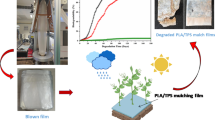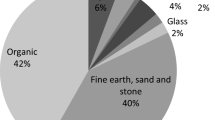Abstract
This study evaluates different hydrothermal pretreatment conditions for the tomato plant. Since these plants produce abundant waste due to their lignocellulosic content, biodegradation through anaerobic digestion is difficult. Hydrothermal pretreatment of the tomato plant was carried out at different times (0, 10, 15, 20, 30, and 60 min), with pressure and temperature conditions maintained at 394 K and 202,650 total Pa. In addition, acid and base were added to determine if they favored the hydrolysis of the lignocellulosic material. After determining the most appropriate pretreatment time for the different options (with or without chemical reagent), aerobic biodegradability was evaluated, as well as the structural changes caused by the pretreatment. From this stage of pretreatment evaluation, it was concluded that the conditions of greatest interest were 15 min (t15) hydrothermal pretreatment without the addition of chemical reagents (TPWH (t15)). The anaerobic digestion process was subsequently evaluated by comparing TPWH (t15) with the untreated tomato plant, obtaining a mean value of 0.125 ± 0.006 and 0.097 ± 0.010 m3STP CH4/kg TVS (total volatile solids) (STP standard temperature and pressure conditions, 273 K and 101,325 Pa), respectively, once the methane production is stabilized.






Similar content being viewed by others
Abbreviations
- RM:
-
Raw material
- TPW:
-
Tomato plant waste
- TPWH:
-
Tomato plant waste hydrothermal
- TPWAH:
-
Tomato plant waste acid-hydrothermal
- TPWAlkH:
-
Tomato plant waste alkali-hydrothermal
- SOUR:
-
Specific oxygen uptake rate
- OD20 :
-
Oxygen demand
- Alk:
-
Alkalinity
- TS:
-
Total solids
- FS:
-
Fixed solids
- TVS:
-
Total volatile solids
- VA:
-
Volatile acidity
- STN:
-
Soluble total nitrogen
- STOC:
-
Soluble total organic carbon
- TOCD:
-
Total chemical oxygen demand
- N-TKN:
-
Total kjeldahl nitrogen
- TP:
-
Total phosphorus
- YCH4/S :
-
Methane yield
References
Food and Agriculture Organization of the United Nations (FAO) (2013) Good agricultural practices for greenhouse vegetable crops: principles for Mediterranean climate areas. Volumen 217 de FAO plant production and protection papers, ISSN 0259-2517. Editor Food and Agriculture Organization of the United Nations. ISBN 9251076499, 9789251076491
Lopez MJ, Masaguer A, Paredes C, Roca L, Ros M, Salas MC, Boluda R (2015) Residuos orgánicos y agricultura intensiva III. Red Española de compostaje, vol 45. Ediciones Peaninfo SA, Madrid, p 58
Fernández J, Gutiérrez F, del Rio P, San Miguel G, Bahillo A, Sanchez JM, Ballesteros M, Vazquez JA, Rodriguez LM, Aracil J (2015) Tecnologías para el uso y transformación de biomasa energética. Mundi-Prensa
Wyman CE (1994) Ethanol from lignocellulosic biomass: technology, economics, and opportunities. Bioresour Technol 50:3–16
Jagadabhi PS, Kaparaju P, Rintala J (2011) Two-stage anaerobic digestion of tomato, cucumber, common reed and grass silage in leach-bed reactors and upflow anaerobic sludge blanket reactors. Bioresour Technol 102:4726–4733
Ren N, Wang A, Cao G, Xu J, Gao L (2009) Bioconversion of lignocellulosic biomass to hydrogen: potential and challenges. Biotechnol Adv 27:1051–1060
Anjum M, Khalid A, Mahmood T, Aziz I (2016) Anaerobic co-digestion of catering waste with partially pretreated lignocellulosic crop residues. J Clean Prod 117:56–63
Mtui GYS (2009) Recent advances in pretreatment of lignocellulosic wastes and production of value added products. Afr J Biotechnol 8:1398–1415
Carlsson M, Lagerkvist A, Morgan-Sagastume F (2012) The effects of substrate pre-treatment on anaerobic digestion systems: a review. Waste Manag 32:1634–1650
Hendriks ATWM, Zeeman G (2009) Pretreatments to enhance the digestibility of lignocellulosic biomass. Bioresour Technol 100:10–18
Lissens G, Thomsen AB, De Barea L, Verstraete W, Ahring BK (2004) Thermal wet oxidation improves anaerobic biodegradability of raw and digested biowaste. Environ Sci Technol 38(12):3418–3424
Pellera F-M, Gidarakos E (2017) Microwave pretreatment of lignocellulosic agroindustrial waste for methane production. J Environ Chem Eng 5:352–365
Gossett JM, Stuckey DC, Owen WF, McCarty PL (1982) Heat treatment and anerobic digestion of refuse. J Environ Eng Div 108:437–454
APHA (1989) Standard Methods for Examination of Water and Wastewater, 17th edn. American Public Health Association, Washington DC
Chica AF, Mohedo JJ, Martin MA, Martin A (2003) Determination of the stability of MSW compost using a respirometric technique. Compost Sci Util 12:119–129
Grupo de investigación RNM-271 Ingeniería química (2007) Universidad de Córdoba. Patente de un Respirómetro automatizado en Fase Líquida; P2004-02908. Publication No. ES2283171 A1
Serrano A, Siles JA, Chica AF, Martin MA (2014) Improvement of mesophilic anaerobic co-digestion of agri-food waste by addition of glycerol. J Environ Manag 140:76–82
Zheng Y, Zhao J, Xu F, Li Y (2014) Pretreatment of lignocellulosic biomass for enhanced biogas production. Prog Energy Combust Sci 42:35–53
Phitsuwan P, Sakka K, Ratanakhanokchai K (2013) Improvement of lignocellulosic biomass in planta: a review of feedstocks, biomass recalcitrance, and strategic manipulation of ideal plants designed for ethanol production and processability. Biomass Bioenergy 58:390–405
Dong H, Bao J (2010) Metabolism: biofuel via biodetoxification. Nat Chem Biol 6(5):316–318
Serrano A, Siles JA, Gutierrez MC, Martín MA (2015) Improvement of the biomethanization of sewage sludge by thermal pre-treatment and co-digestion with strawberry extrudate. J Clean Prod 90:25–33
Chen Y, Cheng JJ, Creamer KS (2008) Inhibition of anaerobic digestion process: a review. Bioresour Technol 99:4044–4064
Lai LW, Idris A (2016) Comparison of steam-alkali pretreatment for enhancing the enzymatic saccharification of oil palm trunk. Renew Energy 99:738–746
Xu H, Yu G, Mu X, Zhang C, DeRoussel P, Liu C, Li B, Wang H (2015) Effect and characterization of sodium lignosulfonate on alkali pretreatment for enhancing enzymatic saccharification of corn stover. Ind Crop Prod 76:638–646
Mou H, Li B, Fardim P (2014) Pretreatment of corn stover with the modified hydrotropic method to enhance enzymatic hydrolysis. Energy Fuel 28:4288–4293
Liu X, Bayard R, Benbelkacem H, Bffière P, Gourdon R (2015) Evaluation of the correlations between biodegradability of lignocellulosic feedstocks in anaerobic digestion process and their biochemical characteristics. Biomass Bioenergy 81:534–543
Buendía IM, Fernández FJ, Villaseñor J, Rodríguez L (2008) Biodegradability of meat industry wastes under anaerobic and aerobic conditions. Water Res 42(14):3767–3774
Wheatley A (1990) Anaerobic digestion: a waste treatment technology. Elsevier, London 371
Water Pollution Control Federation (WPCF) (1967) Anaerobic sludge digestion. Manual of practice No. 16. Water Environment Federation, Alexandria
Lide RD (2004) CRC Handbook of chemistry and physics, 85th edn. CRC Press, Boca Raton
Pilli S, Bhunia P, Yan S, LeBlanc RJ, Tyagi RD, Surampalli RY (2011) Ultrasonic pretreatment of sludge: a review. Ultrason Sonochem 18:1–18
Gil A, Siles JA, Martín MA, Chica AF, Estevez-Pastor FS, Toro-Baptista E (2018) Effect of microwave pretreatment on semi-continuous anaerobic digestion of sewage sludge. Renew Energy 115:917–925
Acknowledgments
The authors are very grateful to the Spanish Ministry of Economy and Competitiveness (Project CTQ2014-60050-R), Ministry of Education, Culture and Sport (Grant FPU2013). We also wish to express our gratitude to Inmaculada Bellido and María Luisa López, as well as Eduardo Espinosa and Juan Domínguez-Robles for their contribution to this research. We also thank the SCAI-UCO for the research support they provided.
Author information
Authors and Affiliations
Corresponding author
Additional information
Publisher’s note
Springer Nature remains neutral with regard to jurisdictional claims in published maps and institutional affiliations.
Rights and permissions
About this article
Cite this article
Gil, A., Siles, J.A., Gutiérrez, M.C. et al. Evaluation of physicochemical pretreatment of tomato plant for aerobic and anaerobic biodegradation. Biomass Conv. Bioref. 9, 489–497 (2019). https://doi.org/10.1007/s13399-019-00380-x
Received:
Revised:
Accepted:
Published:
Issue Date:
DOI: https://doi.org/10.1007/s13399-019-00380-x




